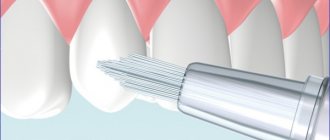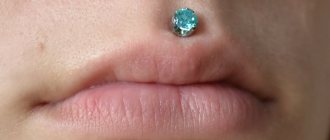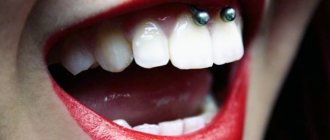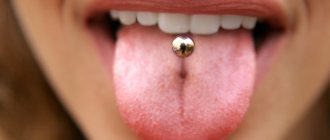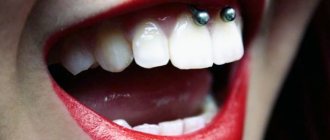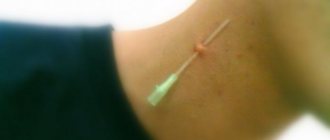Youthful maximalism knows no boundaries. To stand out from the crowd, teenagers are ready for any experiments. Bright hair, provocative makeup, tattoos and even piercings. The latter gained popularity at the end of the last century and to this day is one of the most frequently used methods of self-expression. Young people pierce their eyebrows, lips, nose. However, the most desirable thing is a piercing on a girl's tongue. Owners of such jewelry believe that it is incredibly sexy and try to demonstrate it at every opportunity.
Tongue piercing: to do or not?
Before getting a tongue piercing, you may want to consider broken teeth, drooling, gum and nerve damage, loss of taste, tooth loss, or infections.
All of these problems can result from this procedure. People who have had piercings often develop cracks in their tooth enamel. This occurs due to constant mechanical trauma to the teeth during eating, sleeping, or talking.
The crack may be limited to the enamel of the tooth and require a filling, or it may extend deep into the tooth, in which case endodontic treatment (root canal treatment) or tooth extraction will be required.
We often have to deal with infections. It is known that oral infections can spread to other organs and systems of the body. The surface of the tongue is covered with bacterial plaque. When the tongue is pierced, bacteria enter the bloodstream. Once this happens, the bacteria can travel through the bloodstream, causing a number of serious problems, one of them being endocarditis (inflammation of the heart or its valves).
Tongue piercing is a potential risk factor for the transmission of herpes simplex virus and hepatitis B and C.
When carrying out this procedure (tongue puncture), complications cannot be excluded: nerve damage, prolonged bleeding, which results in numbness of the tongue or loss of sensitivity at the puncture site, or limitation of movement. If blood vessels have been damaged, prolonged bleeding may occur. Swelling of the tongue associated with a piercing can be severe enough to cause blockage of the upper respiratory tract and make breathing significantly more difficult.
Inflammation of the gums. People with barbell piercings are at greater risk of gum disease than people without oral piercings. Jewelry can come into contact with gum tissue, causing damage or recession, which can lead to loose teeth or tooth loss.
Difficulties appear in everyday speech functions.
A tongue piercing can cause difficulty chewing and swallowing food, and may also interfere with clear speech. This happens because jewelry provokes increased salivation.
Temporary or constant drooling is another consequence of excessive saliva production. A change in taste may also occur.
Allergic reactions to metal. A hypersensitivity reaction to metal in jewelry, often called allergic contact dermatitis, can occur in some people. Inhaling jewelry. Jewelry that is not securely secured in the mouth can pose a choking hazard and, if swallowed, may cause injury to the esophagus or lungs.
Tongue piercing can be one of the causes of tongue cancer, as this organ is traumatized.
If you do decide to pierce your tongue, take care of it very carefully. After the piercing, the tongue heals within four to six weeks. In order to avoid complications, the jewelry can be removed for a short time so that the puncture site does not close. Always remove jewelry when eating or sleeping.
To avoid serious infections such as HIV or hepatitis, make sure the piercer uses sterile instruments. Find out all the questions related to aftercare, hygiene and anything else that worries you.
Prepared by: dentist Arefieva Yu.V.
Who and when is not allowed
Sometimes piercings can lead to serious complications and even death.
Direct contraindications are as follows:
- Chronic skin diseases (dermatitis, furunculosis, acne, rashes). If you make a puncture on the affected area, ulcers will appear that will not heal for a long time. They become easily infected. Sepsis may even develop. Later, the wounds can turn into large scars.
- Age . Piercings cannot be done before the age of 15. This is still a child’s body, which is difficult to tolerate damage. Children's tissues become heavily scarred, and injuries can cause immunosuppression. Children are only allowed to have their earlobes pierced (by professionals only).
- Heart disease . The procedure in such patients provokes a heart attack. Even subconscious fear is very dangerous. It provokes a colossal surge of adrenaline. Because of this hormone, the heartbeat accelerates several times. If you have a heart defect, the septum is too thin. It is easily damaged. The patient experiences severe heart pain and even loses consciousness. Sometimes such patients die from rupture of the heart wall and cardiac arrest.
- Kidney failure . It doesn't matter how heavy it is. The issue again is possible stress. Adrenaline can suppress adrenal function. This will provoke an exacerbation of insufficiency.
- Gastrointestinal ulcer . Stress worsens the condition of the gastrointestinal mucosa. The wound can provoke an exacerbation of the ulcer.
- Oncology . With cancer, all the body's forces are thrown into an unequal fight against cancer cells. You shouldn't load it even more.
- Neoplasms of the mammary glands (fibromas, adenomas, fibroadenomas). Due to stress, immunity decreases. It is extremely dangerous in such a state. The neoplasm can develop into malignant.
- Dental diseases (stomatitis, periodontitis, chronic periodontal disease). With such diseases, the oral mucosa becomes irritated. The puncture will become an additional irritant.
- Bronchial asthma . Stress during the procedure can trigger an asthma attack. It can be quite heavy.
- Pregnancy . Any damage can provoke stress and tissue infection. At such an important moment as pregnancy, it is better not to subject the body to additional stress. Remember that stress can cause miscarriage! It is better to postpone the procedure until the baby is finished breastfeeding.
- Lactation . The injury causes stress, which can cause a woman to lose milk. In addition, the body is weakened after childbirth. It is better to go to the salon a couple of weeks after breastfeeding ends.
- PMS . Premenstrual syndrome is a difficult period during which the female body undergoes changes. His hormonal levels change, the girl is weakened and experiences strong emotions. Piercing at this time is fraught with hormonal imbalance, and the growth of cancer cells is even possible in the tissues of the uterus and mammary glands.
- Menstruation . The body is weakened, hormone levels change. There is no need for stress at this time. It can damage the genitourinary, cardiovascular, and gastrointestinal systems.
- Allergy to a number of metals . An extremely unpleasant situation in which the body begins to reject the inserted metal jewelry. The puncture literally rots and a rash forms around it. It will heal over time, but will leave a noticeable scar. To check if you are allergic to any metals, you need to visit an allergist.
- Problems with gynecology . Stress worsens all diseases, including gynecological ones.
- Inflammation of the genitourinary system in men . The mechanism for the development of exacerbation is the same as in women. The trigger point is stress, the release of adrenaline.
Temporary contraindications are also any inflammatory processes. If you have ARVI, flu, colds or an acute form of any disease, you first need to treat them, and then start tuning your appearance.
Side effects of piercing
The side effects that can occur after getting a piercing are numerous. Incorrect installation of piercings in both the upper and lower lips can lead to irreversible consequences, such as damage to the facial nerve. Also, the piercing procedure itself guarantees inevitable swelling and bleeding.
Regular contact of metal parts with tooth enamel leads to its damage, this can be either minor microcracks or severe chips. In fact, the teeth of a person who has had an oral piercing are constantly injured 24 hours a day. When you talk, chew, or simply move your tongue, the hard metal earring continually damages your tooth enamel.
After some time, tiny cracks invisible to the human eye develop into quite serious problems. There is increased sensitivity of the teeth to irritants such as cold, heat and acids. Constant irritation of the nerve leads to caries.
Due to the occurrence of galvanic currents between the metal of the earring and other metals in the mouth, severe irritation of the pulp can occur. Plus, this is facilitated by the acidic environment in the mouth.
Piercing also entails a change in the normal function of the oral cavity. Foreign objects, particularly jewelry in the mouth, can trigger excessive saliva production, which can significantly affect the clarity of pronunciation, as well as chewing and swallowing food. This is not particularly convenient in everyday life.
How long does the procedure take?
The tongue piercing procedure technology includes 3 stages:
- Preparation . Before the wire, the puncture site and decoration - a banana earring or barbell - are treated. To do this, the client rinses his mouth with a diluted solution of hydrogen peroxide for 5 minutes. At this time, the decoration is immersed in a disinfectant solution for 15-20 minutes.
- Puncture . The specialist marks the location of the future piercing, guides the tongue with a tongue holder onto the chin and pierces the tongue from bottom to top with a needle and inserts a polyethylene barbell earring 18-19 mm long with the expectation of future swelling. After the puncture, the client should rinse his mouth again with a solution of hydrogen peroxide and water.
- Healing . Includes piercing care and replacement of jewelry with jewelry 14-16 mm long.
Tongue piercings have both pros and cons.
The advantages include:
- simplicity and painlessness of the procedure;
- due to the protective properties of saliva, infection in the wound is minimized;
- unusual sensations during kissing and oral sex.
The disadvantages of a puncture include:
- swelling and prolonged wound healing;
- violation of diction, taste, tooth enamel;
- before the wound heals, you cannot eat hard, hot, spicy, salty and sour foods;
- there is a high risk of contracting infections from hepatitis C to HIV during a puncture;
- There is a risk of the needle hitting a nerve or blood vessel, which can lead to health problems and even death.
Together with selection, preparation for the procedure and puncture, the tongue piercing procedure takes no more than 20-30 minutes.
Reasons for pain
The following factors can cause characteristic tongue pain:
- Organ injuries.
- Inflammation.
- Allergy.
- Neurological disease.
- Pathologies of internal organs.
- Tumor formation.
- Blockage of the salivary gland.
The most common cause of pain on one side of the tongue is damage to it. As a rule, this is noted during meals. Injuries may include burns, pinching, or scratches. As a result, pain can occur on the upper part, under the tongue or in its side.
Also, a muscular organ can hurt due to a chipped layer of tooth enamel, tingling from the sharp edge of a filling, or prosthetics performed with violations. With mechanical influence, increased pain is noted. In a situation where a patient has difficulty swallowing, and there is also discomfort in the throat or palate, there is a need to visit a doctor and ask him why this is happening.
You should pay attention to the nasopharynx, since as a result of its damage, one sign may appear - swelling of the lymph nodes under the tongue. Many parents are puzzled by the question of why a child’s tongue may hurt at its base, as well as its side, accompanied by plaque and pain when swallowing
But only a qualified doctor can help resolve this issue due to the possible presence of purulent sore throat, which requires immediate administration of adequate therapy
Many parents are puzzled by the question of why a child’s tongue may hurt at its base, as well as its side, accompanied by plaque and pain when swallowing. But only a qualified doctor can help resolve this issue due to the possible presence of purulent sore throat, which requires immediate administration of adequate therapy.
An allergic reaction often occurs due to the fault of certain products, as well as medications. Moreover, signs may appear immediately after their adoption. Some fruits, berries, smoking and alcohol can serve as provocateurs. Neurological disease glossalgia, which arises under the influence of a malfunction of the endocrine system and neurotic disorders. So, a sick person may experience burning, tingling and numbness of the organ.
Diseases of internal organs of unknown etiology often cause pain. All this happens due to various changes in human health, since the tongue reacts sharply to any ailments of an infectious nature - glossitis, as well as pathologies of the gastrointestinal tract, cardiovascular system and even anemia.
Oncological lesions often create conditions for the tongue to begin to hurt on the right or left side. Because of this, the pain syndrome is localized inside the tongue. Moreover, the nature and intensity of pain directly depends on the stage of the malignant disease. In this case, the patient is referred to an oncologist.
Non-infectious problems after piercing
Reactions to piercings are unpredictable and varied, but it is impossible to predict whether a particular patient will have them or not and what they will be. You should remember the risk of problems that are not related to the infectious-inflammatory process, but that affect the functioning of the dentofacial apparatus and the patient’s dental health. Piercing can provoke allergic reactions, periodontopathies, defects in hard dental tissues, tongue abscess, hypersalivation, impaired diction, galvanism, and scar formation [4].
When should you see a doctor?
You should consult a doctor if signs of infection develop
Qualified medical care should be sought if:
- there are signs of infection, such as fever, severe pain, new swelling, or enlarged lymph nodes in the neck;
- symptoms of infection do not subside several days after starting treatment;
- the site of tissue damage constantly bleeds;
- green or yellow pus is released from the site of injury;
- there is an unpleasant odor from the mouth;
- toothache or swollen gums;
- swelling develops or tissue growths form anywhere in the oral cavity.
In addition to meeting with your doctor, you can also visit a piercer and get recommendations on how to relieve pain and other symptoms.
Many piercers give their clients tips to speed up healing and ease discomfort.
However, it is important to understand that consultations with a piercer cannot replace the advice of a doctor.
How to prevent infection
There are many reasons for the development of infection after piercing, and they are not always associated with non-compliance with aseptic and antiseptic methods during puncture. But given the invasiveness of the procedure, you need to carefully choose a salon for piercing, focusing on the recommendations of Rospotrebnadzor. The main points of infection prevention are simple [5]:
- Do not carry out procedures during acute illness (colds, indigestion, herpes rashes, etc.) or during exacerbation of chronic diseases.
- Perform piercing only in a certified center, where the sterility of the instruments and the puncture process is maintained.
- Follow the recommendations for caring for the postoperative wound.
- Take regular and proper oral care [1, 4].
Original and provocative tongue piercing: pros and cons, how it will be
It is worth understanding what it is to decorate your own body, it is far from easy, and you will have to make this decision if you really want to have such an original accessory in your mouth as a stud bar. Moreover, few people realize that tongue piercing, the consequences of which may not be pleasant, to put it mildly, also has a secret sacred meaning. The first such punctures were invented by the ancient tribes of American Indians, who, with its help, performed special rituals to reunite their divine nature with their human nature.
Need to know
The tongue piercing operation is virtually painless and is most often performed without the use of anesthesia or any anesthetics. However, the healing process can be quite painful. For example, you will have to switch to liquid food for a while, give up a lot of things that you are used to, so you should think carefully about everything in advance before agreeing to the procedure.
However, the secret meaning of this action has been completely lost over the centuries, and modern fashionistas and fashionistas are already doing tongue piercing for completely different reasons
Each of these reasons may have their own, but the most common is, of course, giving special pleasure to the partner in terms of sex, and this is an important factor that, of course, must be taken into account
When understanding how tongue piercing is done, the pros and cons of this process should be taken into account first and foremost. First of all, so as not to get serious consequences, and they really can appear soon. It is worth understanding that the puncture procedure can only be carried out by a real professional in the salon. You should not go to his home or invite the master to your place, because it is quite difficult to provide decent conditions for this process.
Contraindications
Piercing is quite popular these days. But tongue piercing is not available to everyone. Before you decide to have surgery and go to the specialist, you need to study the list of contraindications:
- allergy to antibiotics;
- pregnancy period (the risk of infection poses a serious threat to the expectant mother and baby);
- allergy to metals;
- diseases of the nervous system;
- poor blood clotting;
- oral diseases;
- epilepsy;
- some autoimmune diseases (diabetes mellitus, hemophilia).
Tongue piercing is a modern procedure that helps a person stand out among the “crowd.” But before you decide to have a puncture, you need to evaluate all the disadvantages, consequences and dangers of a difficult operation.
Sources used:
- Harden, Blaine. Coming to Grips With the Enduring Appeal of Body Piercing, The New York Times
- A. Stirn (2003): Body piercing: medical consequences and psychological motivations., The Lancet
- Wikipedia material
Possible complications
Below we will look at the main disadvantages of tongue piercing for the oral cavity. All of the listed consequences of this procedure are not “rare exceptions”, but on the contrary, they appear in most cases.
- Infection. Believe it or not, an incredible amount of bacteria accumulates in the mouth. As a result of their vital activity, swelling and inflammation may develop at the puncture site, and an infection may develop. If not treated immediately, the infection can become life-threatening. Another, possibly unexpected complication is tongue swelling. A swollen tongue can block the airway and cause suffocation.
- Damage to teeth and gums. People who bite and play with their piercings run the risk of damaging and weakening their gums. Weakened gums eventually lead to loosening and tooth loss. In addition, this addiction sometimes leads to cracks in tooth enamel and damage to fillings, especially if a person has sensitive enamel. One study found that nearly half of people with a ball-shaped tongue jewel that had been in their mouth for more than four years had at least one chip on their tooth.
- Allergic reactions. People with particular sensitivities to metals are at risk of developing allergies as a result of piercings.
- Numbness. Sometimes people experience numbness after a tongue piercing due to nerve damage. Fortunately, this complication is temporary, but in rare cases it does not go away. Nerve damage can make it difficult to move your mouth and affect your sense of taste.
- Increased salivation. Tongue piercing leads to excessive salivation, impaired diction, difficulty chewing and swallowing food.
- Dental x-rays are difficult. Piercings can make dental examinations difficult because jewelry blocks or distorts X-rays. As a result, you have to “reshoot” several times to achieve a good image.
Possible signs of infection
If an infection is added to post-traumatic inflammation, local and general symptoms of infection occur. Their appearance is associated with a protective reaction at the local and general level of the body in response to chronic inflammation and changes in the microbial composition in the oral cavity. Accordingly, there are differences between local (in the oral cavity and on nearby tissues) and general manifestations of the infectious-inflammatory process associated with a cascade of reactions to the pathological process. These symptoms can appear at any time.
Local symptoms include:
- increased pain;
- the appearance of a twitching pain that can spread (give) to the ear, nose, submandibular area, and head;
- the tongue “tastes” hot, a change in its relief occurs;
- increased swelling;
- in the mirror you can see redness, sometimes whitish films, veins of blood vessels;
- the appearance of cloudy discharge, possibly with an unpleasant taste and odor [4].
General symptoms:
- increased body temperature;
- chills;
- body aches;
- decreased appetite;
- increased fatigue;
- enlargement of local lymph nodes (on the neck, on the back of the head, behind the ears) [4].
Treatment with medical and folk remedies
If the root cause when the tongue begins to hurt is identified as stomatitis, then, as a rule, the specialist prescribes a cycle of antibiotics and treatment of the oral cavity with antiseptic drugs - Miramistin or Chlorhexidine.
If the stumbling block is a disease of the endocrine system, then hormonal treatment is prescribed; as a rule, the problem is determined by diabetes. In a situation where ailments unrelated to dentistry are identified, only one or several qualified specialists can prescribe drug treatment. Traditional methods of treatment can be used if the source of pain does not have serious reasons.
Then, to stop your tongue from hurting, you can rinse with a salt or soda solution, and also hold the oil from sea buckthorn seeds for a while without swallowing.
To exclude such signs, it is important to carefully monitor the hygienic condition of the oral cavity by regularly brushing your teeth and tongue, not forgetting about timely examinations by the dentist, so that you do not end up having to treat the entire body. The main aspect in the implementation of therapy is the impact on the internal part of the body and the implementation of treatment at the local level
The main aspect in the implementation of therapy is the impact on the internal part of the body and the implementation of treatment at the local level.
Is it possible to replace jewelry after the procedure?
Immediately during the procedure, the piercer inserts jewelry into the client - a long barbell made of niobium, platinum, Teflon or gold. It should be smooth, without any irregularities, so as not to injure the fresh tongue piercing and not interfere with the rapid healing of the wound and the formation of the canal.
The long barbell is temporary and after 7-10 days, after the swelling on the tongue subsides, it can be replaced with a permanent, shorter one. But in no case should this be done immediately after the procedure, since the next day after the tongue piercing the tongue will swell, and the short barbell will compress it.
Advantages and disadvantages
The presence of an earring in a person's tongue always attracts everyone's attention to him. The corresponding procedure can be treated both badly and well
But almost always the presence of a puncture arouses interest among others.
Anyone who agrees to have their tongue pierced feels special, different from everyone else. In this way a person wants to show his individuality. And some people decide to get piercings in order to show their decisive character or, conversely, to overcome themselves.
Pros of a puncture
- After the procedure, a person begins to consider himself liberated, courage and determination appear in his character. Anyone who decides to have their tongue pierced “challenges” a monotonous and boring life.
- Tongue piercing is not as noticeable to others as, for example, eyebrow piercing. If necessary, the “decoration” can be removed, and no one will notice the presence of a puncture.
- Improves sexual sensations for a partner. When kissing or performing oral sex, tongue piercing can add additional sexual arousal and add a sense of exoticism to sexual contact.
- After surgery, a long recovery period is required. At this point, you need to follow a strict diet and give up a large list of foods. This restriction helps some people lose weight.
- If all the basics of proper care are followed, the risk of complications is minimal.
- The ability to remove the “decoration” at any time and ensure that the tongue piercing is healed. Thanks to active regeneration of soft tissues, the puncture heals very quickly.
Flaws
- The procedure is very painful. If a person is very sensitive to pain, then it will be difficult for him to undergo such an operation.
- The recovery period, which can “stretch” for several months, also brings a lot of inconvenience. The healing process of the wound surface provokes pain and physical discomfort. It can take from 3 to 6 months before all the unpleasant sensations end.
- Piercing needs to be done only in a specialized clinic or salon, and always by an experienced and qualified master. Many people pierce various parts of the body at home. But in this option, the risk of developing dangerous complications increases sharply. Saving on your own health can cost much more than the cost of surgery in a trusted clinic.
- There is a risk of infection. This often occurs due to the use of unsterile instruments during surgery. The development of infection is not the worst complication of piercing. Complications include hepatitis and herpes. The likelihood of developing complications dangerous to health increases significantly if the procedure is performed by inexperienced or unqualified professionals.
- Tongue piercing almost always damages teeth. This occurs due to the fact that a person has a desire to “chew” or bite the earring. Teeth begin to deteriorate and break for another reason - while chewing food, an unintentional biting of a metal rod occurs.
- If you have a tongue piercing, careful care of your teeth and gums is required. Many young girls and boys, in order to boast about the presence of “decoration” in their mouth, show it off to others who touch the barbell with their hands. All this causes an increase in the number of bacteria and pathogenic microorganisms in the oral cavity.
- Development of gum disease.
- The presence of a foreign body in the oral cavity often provokes the development of discomfort - redness of the mucous membrane, itching, the desire to scratch the tongue.
Puncture procedure
Tongue piercing is an operation. To avoid complications, it is recommended to carry it out in a specialized salon. Only a qualified doctor can perform the procedure properly. Only a master can determine the optimal place for a puncture, where the risk of injury to nerves and blood vessels will be minimal.
During the operation, sterile instruments and disposable rubber gloves must be used.
Sequencing:
- The oral cavity is treated with an antiseptic. In most cases, patients ask for additional oral anesthesia. Lidocaine solution is used as an anesthetic.
- A special clamp is used to fix the tongue.
- A puncture is made on the tongue fixed with a clamp. The direction of the needle is from bottom to top.
- A metal rod or a “decoration” chosen by the patient is inserted into the resulting hole.
Tongue piercing at home
It is not advisable to do piercing yourself.
To minimize the risk of complications, the following requirements must be met:
- A well-lit place is selected for the operation. There must be a table in the room on which the necessary tools are laid out.
- For the operation, only sterile instruments (clamp, needle, earring) are used.
- The oral cavity must be treated with a disinfectant solution and, if necessary, irrigated with an anesthetic drug.
- For the puncture site, select the part of the tongue located closer to the tip. There are no large blood vessels in this area of the organ.
- The tongue is clamped with forceps.
- A special needle pierces the soft tissue of the organ strictly perpendicular to the surface.
- The bar is threaded. It is recommended to use a catheter to insert the “decoration”.
A catheter is a special device that helps you do piercing at home. Thanks to the catheter, the sensation when piercing the soft tissue of the tongue is less painful.
The catheter is a small needle equipped with a plastic tube. An earring or other “decoration” is inserted into the cavity of the tube. After the puncture, the earring goes into the hole along with the needle. Subsequently, the needle and catheter are removed, and the “decoration” remains in the inner part of the tongue.
How is it done and how long does tongue piercing take to heal?
First, let's figure out how the procedure itself occurs so that we know in detail what to expect. Thorough preparation is what can guarantee a good result, as well as a proper healing process.
In the salon, the master must use a special clamp, which has a hole for a puncture. He clamps the tongue in a clamp and pierces it using a special sterile needle.
Moreover, it is better if the needle is disposable, as there is much less chance of getting an infection, and this is very important. Next, the master, through a special hole in the needle itself, inserts the stud bar directly into the tongue, after which both the clamp and the needle are removed. After the procedure, you must rinse your mouth with any disinfectant solution. An excellent option would be Chlorhexidine diluted in a ratio of one to four with water.
Around evening, the tongue will definitely swell and you will have to put up with such inconvenience, as this is inevitable. Healing may occur at different rates in different people, and depending on the quality of the tongue piercing procedure. It can be over in five days, or it can take two weeks to heal. Moreover, for this entire period you will have to completely abandon hot spices, acids, and, in general, solid food. It is also recommended to talk less in the first days, as you can easily injure the wound.
The degree of pain of the procedure
Any operation is painful. And tongue piercing is no exception. The puncture procedure itself lasts a couple of seconds. The patient feels a sharp, but quite tolerable pain. The main painful sensations begin at the stage of healing of the wound surface. The lining of the tongue is highly sensitive, and since this organ of the body is constantly moving, the pain will be excruciating. The discomfort will continue until the wound heals.
It is possible to reduce the intensity of painful sensations. To do this, you must adhere to the following basics:
- The operation should only be performed in a specialized clinic (salon) by a qualified specialist;
- During the recovery period, constantly care for the wound;
- stop smoking and drinking alcoholic beverages (at least for the recovery period);
- try to talk less in the first days after surgery;
- Avoid eating hot and spicy foods.
Risks
In general, tongue piercing is a fairly safe procedure. The biggest risk it poses is infection of the wound soon after the healing process begins. However, most infections are mild and can be easily treated with oral antibiotics.
However, sometimes people develop severe infections, such as abscesses. In such situations, the person may require hospitalization or intravenous antibiotics.
In addition, piercing is associated with the following risks:
- damage to teeth and gums;
- gum recession on the inside of the mouth;
- Ludwig's tonsillitis is a rare type of skin infection that develops under the tongue.
- Accidental ingestion of jewelry, which may result in choking or throat damage;
- acquiring diseases such as tetanus or HIV if the piercer uses unsterile instruments or jewelry that has already been used before.
- spread of infection to the blood or other organs (rarely observed).
In some cases, the body rejects the piercing, which can lead to further complications.
Tongue piercing procedure
Tongue piercing is a surgical procedure. Although it is short-lived, it can be very dangerous to health, and in certain cases, to life. The procedure is a sharp puncture of the soft mucous membrane of the tongue with the further introduction of a special earring or barbell.
Among the huge variety of “decorations”, the most common are vertical rods cast from medical titanium or steel. In appearance, the earring turns out to be double, that is, it can be seen both from above and, if you lift your tongue, from below.
Another popular type of piercing is the frenulum. This procedure for introducing a frenulum into the tongue is less painless; during the operation, the client releases less blood, and, accordingly, healing of the wound surface occurs much faster.
Other "decorations":
- rings;
- carnations;
- staples.
Stages of the healing process
After a tongue piercing, it usually takes 4–6 weeks to heal
Each person's body has its own individual characteristics, so the healing process occurs differently in different people. If your immune system is weak, which may be due to diabetes, cancer, HIV, or certain medications, recovery takes longer and the body is usually more susceptible to infections.
Typically, after a tongue piercing, healing goes through the following three stages.
1–3 days after the procedure
Immediately after the piercing, the wound may be irritated and painful. In addition, people often experience discomfort when pronouncing words due to the fact that they cannot yet get used to a foreign object in the oral cavity.
However, during this period it is important not to touch the tongue with your hands or teeth, as this may increase irritation.
Initially, it makes sense to try to place food on the teeth to chew it, and some people prefer to eat shakes or other liquid foods for the first few days.
During this time, it is also important to rinse your mouth with a saline solution several times a day. Piercers recommend preparing them by diluting a quarter teaspoon of iodine-free salt in a glass of warm water.
You should not use more concentrated solutions or creams with antibiotics unless your doctor recommends this. Additionally, it is important to follow the instructions provided by the piercer.
It is also recommended to use a new toothbrush after piercing to reduce the risk of harmful bacteria entering the damaged area.
Swelling and inflammation. From 4 to 10 days
Within a few days after the piercing, swelling of the tongue usually increases. This symptom usually lasts up to a week or a little longer. The wound may bleed or ooze
It is important to understand that minor bleeding usually does not indicate serious problems, but if the blood flows constantly, then you should consult a doctor. A few days after the procedure, wounds often begin to ooze a whitish or clear fluid.
When the swelling subsides, you need to replace the jewelry with a shorter one, since long pieces exacerbate irritation and can damage your teeth. Ideally, jewelry changes should be performed by a piercer.
Always wash your hands thoroughly before touching the piercing.
It is also important to use only new and sterile jewelry for insertion into the tongue.
During this period, the risk of developing infection is very high.
It is important to know that its dangerous symptoms include the following:
- severe swelling;
- growing pain;
- fever;
- pus coming out of a wound.
Early healing. From 10 to 30 days
Piercing wounds heal from the outside in, meaning the outer tissue of the tongue is initially restored. Therefore, even when the damaged area begins to seem less irritated, it may actually take several more weeks for complete healing.
At this stage of the healing process, the wounds usually become less painful, but the person may still need time to get used to the foreign object in the mouth.
Typically, the tongue heals quickly, which means that soon after the jewelry is removed, the tissues of the tongue can come together.
Scarring and complete recovery. From 4 to 6 weeks
Essentially, a piercing is a scar, and it takes the body some time to form it.
In the absence of complications, complete healing usually occurs in 4–6 weeks. If, after a month, swelling continues to be observed in the tongue, as well as in cases where, after apparent healing, swelling and soreness occur again, the person may develop an infection or other problems.
Typical symptoms after piercing
Of course, not every piercing leads to infection, but some vigilance is needed. A tongue piercing is an injury, and it heals in the same stages as other injuries. This stage lasts, according to various sources, up to 10–14 days. Typical complaints and symptoms after piercing are:
- swelling;
- pain or discomfort in the puncture area;
- feeling of tightness, numbness of the tongue;
- tingling, burning, especially when food, drinks, or medications come into contact with the wound;
- discharge of a small amount of blood or yellowish serous fluid [1, 4].
Installed jewelry can be a factor of permanent trauma, and this leads to chronic low-grade inflammation, in which there is minor local swelling and slight redness due to disruption of the integrity of the epithelium.
Which metal jewelry should you prefer?
For the first time after surgery, it is recommended to wear simple jewelry that is not framed with stones or patterns. Select the following material:
- Hypoallergenic plastic.
- Can be replaced with Teflon.
- If gold, then only high standard - 585 or 700.
- You can use surgical implant metal, but then replace it with a more expensive material.
When the hole is completely healed, you can afford another decoration. For lips, try to give preference to hypoallergenic materials. They have high biocompatibility with human skin and tissues. Moreover, they do not irritate the mucous membrane. In addition to standard metals, these can be amber, wood, niobium and even ivory.
Despite the widespread use of surgical metal products, you should not wear them immediately after a piercing. Due to the high concentration of nickel, such earrings often cause complications and suppuration of wounds.
Decoration selection
It is important to choose the right decoration. There are different types of earrings. Most often, a barbell is inserted. It helps the wound heal and fits perfectly into the hole. In a jewelry store you can really choose a barbell to suit every taste.
For side piercings, half rings are used; they have a bead-shaped tip. For a fresh hole, this decoration is ideal.
Immediately after the puncture, a large earring is inserted (length - 16-22 mm). The bar must move freely inside the canal, since after the puncture the tongue will swell.
At first, the hole clamps should be large so that they do not slip into the channel. Then you should choose something sophisticated. These can be figurines, pearls, flies. The bottom lock should be comfortable.
Piercing: advice from dentists
You already know the attitude of dentists towards piercing! But what to do: if your lip and tongue are already pierced, and you decide to keep up with fashion? How can you reduce the risk of oral piercings to your teeth and gums?
- Dentists recommend installing plastic ones instead of classic metal jewelry. This material is much softer, which means that the risk of causing damage is much lower. But plastic products also have their disadvantages. For example, today it is not known exactly which types of plastic cause allergic reactions, while, for example, titanium is a completely hypoallergenic material.
- It is better to remove jewelry before eating or going to bed. For this purpose, there are special plugs that allow you to compensate for the product during sleep.
- When piercing the tongue, it is better to remove the jewelry before going to bed or while brushing your teeth. This can be done after the wound from the piercing has completely healed.
- After each meal, it is advisable to rinse your mouth with a special antiseptic solution.
- Injury to teeth and gums can be avoided by removing the piercing before any vigorous activity.
Types of earrings for piercing
Surprisingly, a men's box with this kind of jewelry can surprise even sophisticated ladies. Precious metals (silver, gold), as well as surgical steel and even titanium, can be used to make accessories. Among young people, plugs and extenders made of silicone and natural materials (bone, wood, stone) are more popular. Fans of club life should take a closer look at glow-in-the-dark baubles, which are often made of silicone and acrylic.
The shape and materials of piercing accessories are very diverse.
As for the shapes of earrings, it is quite difficult to understand without a special dictionary of terms from a male piercer. If even youngsters who have recently crawled out of tights and shorts have heard about rings, studs, barbells, bananas and tunnels, then only those initiated into the caste of piercers know about stretch marks, labrets, circulars, skin divers and other gadgets.
Among the new products, it is worth mentioning special transparent earrings, designed for those who do not want to part with their favorite accessory, but the situation and dress code do not allow them to openly wear labrets in their lips or ears. Retainers are also suitable for athletes.
Transparent earrings for people constrained by dress codes
A special group consists of microdermals, many of which have an internal and external part. At the same time, the base implanted under the skin is often made of titanium, but the replaceable head is made of surgical steel. This type of puncture can also be perfectly camouflaged, which is perhaps why titanium body painting is popular among men who sit in stuffy offices during the day and turn into wild pubgoers in the evening.
What piercings are not customary for men?
Girls decorate themselves mainly for the sake of aesthetics and to comply with fashion trends. With the help of earrings and other accessories, girls emphasize the beauty and seductiveness of the female form. In addition to traditional areas, young women decorate the skin in the collarbone area, in the hollow between the breasts, and the navel. More extreme types of soft tissue punctures, popular among girls - the so-called. a corset, when the area of the back, ankles or wrists is pierced with needles in two rows, after which rings are inserted there, through which a decorative lace or ribbon is threaded in the form of a corset tie.
The male way of decorating himself is more restrained in terms of decorativeness. Representatives of the stronger sex do not use earrings with stones, rhinestones, or beads; instead, they prefer to wear simple metal products made of titanium, medical steel and other alloys.
Where can I get my tongue pierced, cost?
It is better to have your tongue pierced in a professional clinic or beauty salon. The operation can be performed at home, but in this case there is a high risk of complications due to lack of experience and qualifications.
The cost of the procedure depends on the region and professional qualities of the specialist. The average price for a puncture in Moscow is from 1,500 rubles. up to 2200 rub. In the region, the cost can vary from 1100 rubles. up to 1900 rub.
When choosing a clinic, you should pay attention to what tools are used by the master. A good level of training shows the availability of special equipment for diagnosing various contraindications or structural features of the mucous membrane.
